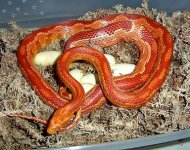My Amel is about 7 months old and I noticed after her last shed she has some random light grayish/tan scales on her, the same color as the belly checks. Some are next to the saddles, some are just off randomly by themselves. Is that common on amels? She's het for Charcoal and Anery but from my understanding hets don't show. Tried to get a picture but not sure how well it shows.






